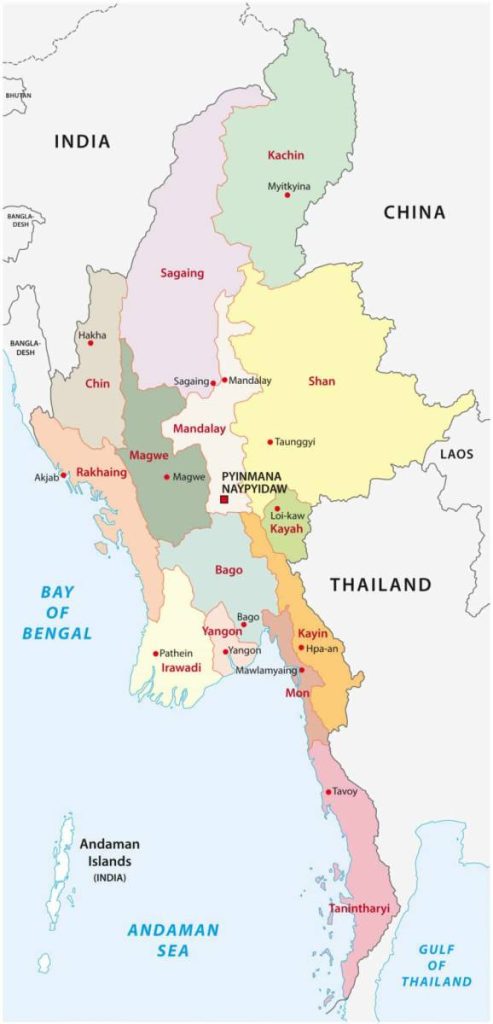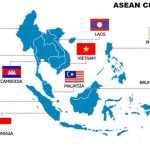
Myanmar and India have a long land border that is over 1600 km long. They also have a sea border in the Bay of Bengal. Myanmar shares an international border with four North-Eastern states: Arunachal Pradesh, Nagaland, Manipur, and Mizoram.
Both countries have religious, linguistic, and ethnic links that go back a long way. Myanmar and India have had “historical ties and traditional bonds of friendship and cooperation” Buddhism, Business, Bollywood, Bharatanatyam, and Burma teak are the five things that keep India and Myanmar together.
India is a holy place for the people of Myanmar because it is where Lord Buddha was born. The friendship between India and Myanmar has stood the test of time. The closeness of the two countries has made it easier for people to get to know each other and keep up friendly ties.
Myanmar has between 1.5 and 2 million people who were born in India. Also, Myanmar is a gateway to South East Asia and the Association of Southeast Asian Nations (ASEAN), with which India wants to have more business ties through its “Neighbourhood First” and “Act East” policies. Myanmar also provides another way to get to the Northeast.
Aside from the supply of pulses, mutual relations are based on the possibility of energy supply from offshore blocks in Myanmar and the business opportunities that come from an opening economy.
In 1951, India and Myanmar made a deal to be friends. When Prime Minister Rajiv Gandhi went to Myanmar in 1987, he laid the groundwork for better ties between India and Myanmar. Several deals that make it easier for the two countries to work together have been signed. Institutional processes have also been set up to make it easier to talk regularly about a wide range of issues that are important to both countries.
In 2002, the Indian Consulate General was reopened in Mandalay, and the Myanmar Consulate General was set up in Kolkata. After the devastating cyclone “Nargis” hit Myanmar in May 2008, India sent rescue supplies and offers of help right away. India also gave US $1 million to help with humanitarian aid and rebuilding in the places hit by the March 2011 earthquake in Shan State.
Table of Contents
- 1 Political Areas of Cooperation
- 2 Act East Policy:
- 3 Neighbourhood First Policy
- 4 Buddhist Circuit:
- 5 Economic
- 6 Trade and Transit
- 7 Defence cooperation
- 8 Diaspora and Culture:
- 9 Regional Cooperation
- 10 ASEAN (Association of South-East Asian Nations for Regional Cooperation)
- 11 Bay of Bengal Initiative for Multi-Sectoral
- 12 Mekong Ganga Cooperation
- 13 South Asian Association for Regional Cooperation (SAARC):
- 14 Disaster relief:
- 15 Capacity Building:
- 16 How important Myanmar is for India
- 17 India’s main goals in Myanmar are
- 18 Challenges in Relations
- 19 Insurgency in North East India:
- 20 Economic
- 21 Connectivity:
- 22 Relations with China:
- 23 Trans-Border Militancy:
- 24 Rohingya Crisis:
- 25 Way Forward
- 26 Conclusion
Political Areas of Cooperation
• Since the 1990s, India has had a policy of trying to improve relations between governments. This policy is based on the fact that India and other countries have similar cultures. Aung San Suu Kyi’s National League for Democracy (NLD) won the general elections in November 2015 by a huge margin, and the NLD formed a government. This gave us a chance to strengthen our participation and build on what we had already done.
• Narendra Modi, the Prime Minister of India, went to Myanmar in November 2014.
• The leaders talked a lot about how to make it easier for people to travel between what they called “brother countries.” The two leaders talked about the need for more direct air links, an India-Myanmar-Thailand trilateral highway, and the Kaladan multi-modal transport project. They also talked about other economic ties and cooperation in the oil and gas sector, as well as the need for more cultural contacts, such as sending Myanmar’s students to Nalanda University.
• Both leaders said it was important to build on the natural, cultural, and historical ties between the two countries.
• During the East Asia Summit, PM Modi met with the leaders. During his speech to the leaders of ASEAN, he also told them about India’s new Act East Policy.
• Aung San Suu Kyi, the State Councillor of Myanmar, went to India to take part in the BRICS-BIMSTEC Outreach Summit.
During the visit, Myanmar said again that it would not let its land be used against India. Ms. Swaraj told Ms. Suu Kyi that India would “help in any way” to “strengthen” Myanmar’s “democratic institutions and socio-economic development” and would also help Myanmar become “better connected” in the future.
After Prime Minister Narendra Modi and Ms. Suu Kyi met, they signed three agreements to help the insurance, power, and banking industries.
But it is important to remember that she had been to China before she came to India. So, her visit was a warning that India has a long way to go if it wants to have as much power over Myanmar as China.
• In August 2016, the president of Myanmar went to India. This was the first visit of its kind in more than 50 years. This was also his first trip outside of India after taking office, which shows how important Myanmar is to India. When Pranab Mukherjee was president of India, he said that Myanmar was a “key partner” in India’s “Neighbourhood First” and “Act East” policies. Both countries also said they were ready to work together to improve marine security in the Bay of Bengal. How well the “Act East Policy” works will depend on what happens in Myanmar.
• The Prime Minister of India, Shri Narendra Modi, has put a lot of emphasis on several policies that keep Myanmar at the top of India’s regional diplomacy. These include: the “Act East” policy, the “Neighbourhood First” policy, the “Buddhist circuit” initiative, a greater focus on regional connectivity, and a mandate to strengthen border security.
• Myanmar has been in turmoil since February 2021, when the military took control of the country in a coup and jaile
Act East Policy:
One of the most important things the Indian Prime Minister has said about foreign policy since he took office was to change the “Look East” policy to the “Act East” policy. He talked about the new plan at the 12th India-ASEAN meeting, which was held in Myanmar in November 2014.
Neighbourhood First Policy
• In November 2014, at the 18th SAARC Summit in Kathmandu, India’s Prime Minister talked about his plans for South Asia. He talked about “destinies that are linked” and “shared opportunities.” Myanmar is in a good position when it comes to the “neighbourhood first” policy.
• India has realised that it needs to bring its neighbours along with it as it grows. This is the best way to keep the area stable, which is important for development. However, India has a long way to go if it wants to match Chinese influence over Myanmar.
Buddhist Circuit:
• The big “Buddhist Circuit” project aims to connect all of India’s most important Buddhist sites. Myanmar has been connected to India through Buddhism for hundreds of years. There are a lot of Buddhists in Myanmar who want to go to India for faith reasons. India’s Buddhist influence set the stage for a strong cultural connection between the two countries, but it wasn’t used much until lately. Over 80% of the people who live in Myanmar are Buddhist.
Economic
• Bilateral and multilateral economic ties and interdependencies help figure out how a country’s economy will grow and succeed, as well as its chances of economic growth. India and Myanmar set up a Joint Trade Committee (JTC) in 2003 to look at their trade and growth. They did this because they saw the benefits of working together on the economy. In 2017, the Commerce Ministers of the two countries led the 6th JTC together.
• In 2008, the two countries signed a Bilateral Investment Promotion Agreement (BIPA) and an agreement to avoid double taxation (DTAA).
• Both countries have signed the India-ASEAN Trade in Goods Agreement, and Myanmar acts as a bridge between India and the ASEAN countries. Bilateral trade has grown from US$ 12.4 million in 1980–81 to US$ 1,338.29 million in 2010–11. Most of what India buys from Myanmar are agricultural goods like beans, peas, and forest products, which make up 90% of what India buys from Myanmar. India’s major exports to Myanmar are raw steel, steel that has been partially processed, and medicines.
Trade and Transit
• India and Myanmar signed a border trade deal in 1994, and there are two border trade points, Moreh-Tamu and Zowkhatar-Rhi, that are open for business. The border between the two countries is 1643 km long. At Avakhung-Pansat/Somrai, it is planned to open a third border trade point. During the 3rd India-Myanmar Joint Trade Committee in October 2008, it was decided that Border Trade at the current points would be changed to Normal Trade to help trade between the two countries. Both sides have sent notices that this is the case.
• On October 22, 2018, India and Myanmar signed an important MoU for the selection of a private port operator for the operation and maintenance of Sittwe Port and related facilities as part of the Kaladan Multi Model Transit Transport Project.
India and Myanmar are working on a project called the Kaladan Multi-Modal Transit Transport Physical Connectivity Project.
India Myanmar Defence work on the Thailand Trilateral Highway Project
• The Indian and Myanmar armies have fought militants along the borders of Myanmar’s Rakhine state in two joint military operations called “Operation Sun Shine.”
• India gives the Myanmar Army military training and does joint military exercises with it, such as the India-Myanmar Bilateral Military Exercise (IMBAX-2017 and IMBEX 2018-19). Through these exercises, India has prepared the Myanmar Army to take part in UN Peacekeeping Operations.
• India and Myanmar signed a historic deal to work together on defence.
• The navies of both India and Myanmar took part in IMNEX-18, a historic naval practise between the two countries.
• India also asked the Myanmar Army to join the multilateral Milan naval drill, which happens every two years in the Andaman and Nicobar Islands and is led by India.
• India thinks Myanmar is the key to growing its military exports and improving its “Made in India” arms business. Myanmar got TAL Shyena, the first anti-submarine torpedo made in India, and INS Sindhuvir, a diesel-electric Kilo-class submarine.


Defence cooperation
• In 2019, Indian and Myanmar forces worked together on Operation Sunrise and Operation Sunrise 2 to destroy several rebel camps on their own land. However, the Kaladan multi-modal transit transport project, which is India’s gateway to Southeast Asia, is still at risk.
• India has also helped Myanmar fight Rohingya rebel groups like the Arakan Rohingya Salvation Army (ARSA) and Aqa Mul Mujahideen (AMM). This is because Indian intelligence agencies found that the ARSA and AMM had ties to terror groups like the Lashkar-e-Taiba (LeT) and Jaish-e-Mohammed (JeM), and there were reports of Rohingya terrorists fighting with Pakistani extremists in Kashmir.
Diaspora and Culture:
Between 1.5 and 2.5 million people from India live and work in different parts of Myanmar. When the British took over Lower Burma in 1852, the Indian society there can be traced back to the middle of the 19th century. During British rule, there were a lot of Indians working in government, schooling, trade, and business in Yangon and Mandalay.
India and Myanmar have strong cultural links and a deep sense of family because India is a Buddhist country. A Memorandum of Understanding (MoU) was signed on the restoration of pagodas in Bagan, which shows how close the two countries are. Also, the Agreement on Land Border Crossing, which was signed in May 2018, is a turning point in the relationship between the two countries because it will allow people from both countries to cross the land border with a passport and visa, including for pilgrimage, health care, education, and tourism. Manipur and Mizoram recently opened two land border crossings.
Regional Cooperation
ASEAN (Association of South-East Asian Nations for Regional Cooperation)
• Myanmar joined ASEAN in July of 1997. Myanmar is a bridge between India and ASEAN because it is the only ASEAN country that shares a land border with India. Some ideas for cooperation have already been put into action, and others are being talked about with Myanmar as part of ASEAN’s IAI plan.
Bay of Bengal Initiative for Multi-Sectoral
Myanmar joined BIMSTEC (Bay of Bengal Initiative for Multi-Sectoral Technical and Economic Cooperation) in December 1997. Myanmar is a part of the BIMSTEC Free Trade Agreement because it signed it. Myanmar is the most important country in the energy field. In the BIMSTEC region, Myanmar does most of its business with Thailand and India. Myanmar’s main exports to India are farming goods like beans, lentils, and maize, as well as forest products like teak and hardwoods. It gets chemicals, medicines, electrical tools, and transportation equipment from India. In January 2011, the 13th BIMSTEC Ministerial Meeting was held in Myanmar.
Mekong Ganga Cooperation
Myanmar has been a part of the Mekong Ganga Cooperation (MGC) since it started in November 2000.MGC is an effort by India and five ASEAN countries (Cambodia, Laos, Myanmar, Thailand, and Vietnam) to work together in tourism, education, culture, transportation, and communication.
South Asian Association for Regional Cooperation (SAARC):
• In August 2008, Myanmar joined SAARC as a spectator. India is in favour of Myanmar becoming a full member of SAARC because it would be good for both countries on a military and economic level if they worked together more.
Disaster relief:
• India helped Myanmar after natural disasters like the 2010 earthquake in Shan state, Cyclone Mora in 2017, and Komen in 2015. They did this quickly and well.
• India offered to help Myanmar build its ability to deal with disasters and reduce the chance of them, as well as to improve its National Disaster Response Mechanism.
• In January and February of 2021, India gave Myanmar 1.7 million Covid-19 vaccines.
Capacity Building:
• Capacity building has been a top concern. Several new institutions have been set up to teach agriculture, IT, and industrial skills, which have helped Myanmar’s young people a lot.
• The Myanmar Institute of Information Technology in Mandalay, which was set up with help from IIIT Bangalore, has been a success. All of its graduates have been able to find jobs right away.
• The Advanced Centre for Agriculture study and Education, which was set up with the help of India’s ICAR, is a great example of how study on pulses and oilseeds can benefit from working together.
• India has also said it wants to build a plant for oil in Myanmar. This shows that Myanmar is becoming more important in India.
• India has regularly strengthened defence ties with Myanmar by building more training facilities and giving the country’s military the defence equipment it needs.
• India sent medicines and tools at the right time to help fight the corona outbreak.
• Several Indian companies, including oil and gas companies like ONGC Videsh and GAIL, have also set up shop in Myanmar.
• India has also agreed to train Myanmar army leaders and let them study at military academies in India.
How important Myanmar is for India
In the early 1990s, when India announced its “Look East” policy, Myanmar became a very important part of Delhi’s relationship with South East Asia. Myanmar is the natural land bridge between India and South-East Asia. Given that India and Myanmar share a large maritime border in the Bay of Bengal and that southern Myanmar is at the point where the Indian and Pacific Oceans meet, India’s eastern neighbour has become an important part of its new marine strategy.
• Because SAARC is in a bad place, India is looking to BIMSTEC, and Myanmar can play a key part in this new strategic setting.
• For the security of India’s North-Eastern States, Myanmar needs to help stop insurgencies and trade. Myanmar is both directly and indirectly affected by the conflict in the South China Sea, even though it is not a part of it. It has a direct effect on geography because it is next to China. India needs to work with Myanmar because of the rivalry between the US and China and China’s growing assertiveness in the area.
• As part of India’s SAGAR Vision, India built the Sittwe port in Myanmar’s Rakhine state.
• The port is India’s answer to the Chinese-backed Kyaukpyu port, which is meant to solidify China’s geostrategic footprint in Rakhine.
• It is in India’s best interest for Myanmar to be a stable and independent country, which would allow for more bilateral engagement between India and Myanmar.
India’s main goals in Myanmar are
• To make sure that Myanmar doesn’t fall into China’s sphere of influence by building economic and security ties with it.
• Get the Myanmar military to help stop terrorists from the Northeast, especially Naga insurgents, from using Myanmar as a safe haven.
• Help the country become a fully functioning federal government.
• Help the Rohingya people and make sure that the tense relationship between Bangladesh and Myanmar doesn’t get out of hand.

Challenges in Relations
Insurgency in North East India:
Due to insurgency, India faces security and strategic problems along the porous border between India and Myanmar. Along the border between India and Myanmar, there are problems with smuggling, drug trafficking, and crimes like smuggling goods, arms, and fake Indian cash. In this situation, India’s problems with insurgencies in the Northeast cannot be solved without help from Myanmar.
Economic
• India-Myanmar trade has stayed below both countries’ hopes. This was because Myanmar set exchange rates for its currency that were too high. Also, there was almost no financial infrastructure, like banks and the rules that go with them.
• India thinks Myanmar is important if it wants to reach its goal of having a $5 trillion economy by 2024. But with only $2 billion in trade between the two countries, India’s economic ties with Myanmar are not as strong as those with China.
Connectivity:
• The lack of land and sea connections between India and Myanmar is one reason why trade with India isn’t very high.
Relations with China:
• Myanmar’s growing dependence on China is shown by the fact that the two countries have upgraded their relationship to “a comprehensive strategic cooperative partnership.”
• Myanmar and China have agreed to improve cooperation in border management and work together more with the U.N. and ASEAN.
• Myanmar’s president has called the relationship with China “the closest and most important diplomatic relationship.” India’s interests and the stability of the area are hurt by China becoming more important.
Trans-Border Militancy:
• The ambush by NSCN (K) on an Indian Army convoy in Chandel district in Manipur on June 4, 2015, killing 18 soldiers and injuring 15, and the counter strike by the Indian Army on June 9 against two different groups of insurgents along the India-Myanmar border, have given a new dimension to the trans-border militancy with Myanmar. Later, when the Indian Army did surgical strikes on the insurgent groups, they did a lot of damage to ultras.
Rohingya Crisis:
• There are 16,500 Rohingya people in India, who live in different places. The long-standing problem of the Rohingyas in Myanmar has recently become a point of debate in India. The Indian government is asking that they be sent back to Myanmar because they are seen as a threat to India’s national security and are linked to Jihadist groups. India’s claim that the Rohingyas should be sent back to Myanmar is based on the idea that the refugees are from Myanmar. But the Burmese don’t think of the Rohingyas as their own people. Instead, they see them as foreigners who came from Bangladesh when the British ruled the country. The Rohingyas have been passed from one state to another, so the United Nations calls this group of about a million people who are “floating in mid-air” “stateless.
“At first, India was seen as hesitant to take a firm stance on the Rohingya problem, and this reluctance hurt India’s reputation as a leader in the region. China did a lot more to help solve the problem and was a lot more aggressive. Later, India made it clear that it wants the Rohingya people to come back “safely, securely, and for the long term.” India and Myanmar made an agreement in December 2017 to help the Rohingya return to their homes in a safe way. One of the main goals of the agreement was to build prefab homes in Rakhine state for the displaced people.
Way Forward
• Recognising that the military is most important: Myanmar’s army would be a big part of any shift to democracy there, so India would need to work with the military there.
Even though India will keep calling for the democratic process to be brought back, it will also talk to the army in Myanmar about Indian worries. Putting the army on the back burner will only drive it into the arms of China.
• Cultural diplomacy: India can improve its ties with Myanmar by using Buddhism as a lens for its cultural diplomacy.
India’s “Buddhist Circuit” project, which aims to double the number of foreign tourists by connecting old Buddhist heritage sites in different states, should appeal to Myanmar, which is mostly Buddhist.
This could also help India build respect and trust with Buddhist-majority countries like Myanmar.
• Solving the Rohingya problem: The faster the Rohingya problem is solved, the easier it will be for India to deal with its relationships with Myanmar and Bangladesh. Instead, India can focus more on economic cooperation between the two countries and in the subregion.
• India, the world’s biggest and most active democracy, can share its knowledge and best practises with Myanmar to help make the country’s democratic development stronger and more adaptable in the years to come.
• Building institutions, developing people resources, and building capacity are also areas where both sides can work together to help each other. Myanmar can learn a lot from how India treats its religion and ethnic minorities when it comes to making its own policies.
Conclusion
• Like Myanmar’s other close friends, India needs to reach out and make its own path in Myanmar.
• India’s regional security and neighbourhood are complicated, so it needs to take a more nuanced position with Myanmar without giving up its pragmatic nature.
• India’s relationship with Myanmar has slowly grown over the last 20 years. The main goals were to get high-level political talks, business ties, and cross-border connections between India’s North East and northern Myanmar back on track.Going forward, India wouldn’t have to let other countries take the lead on big issues in Myanmar if it was proactive. India has a lot riding on global and regional governance, so it needs to make sure that its voice is heard on important topics like the Rohingya crisis.
















